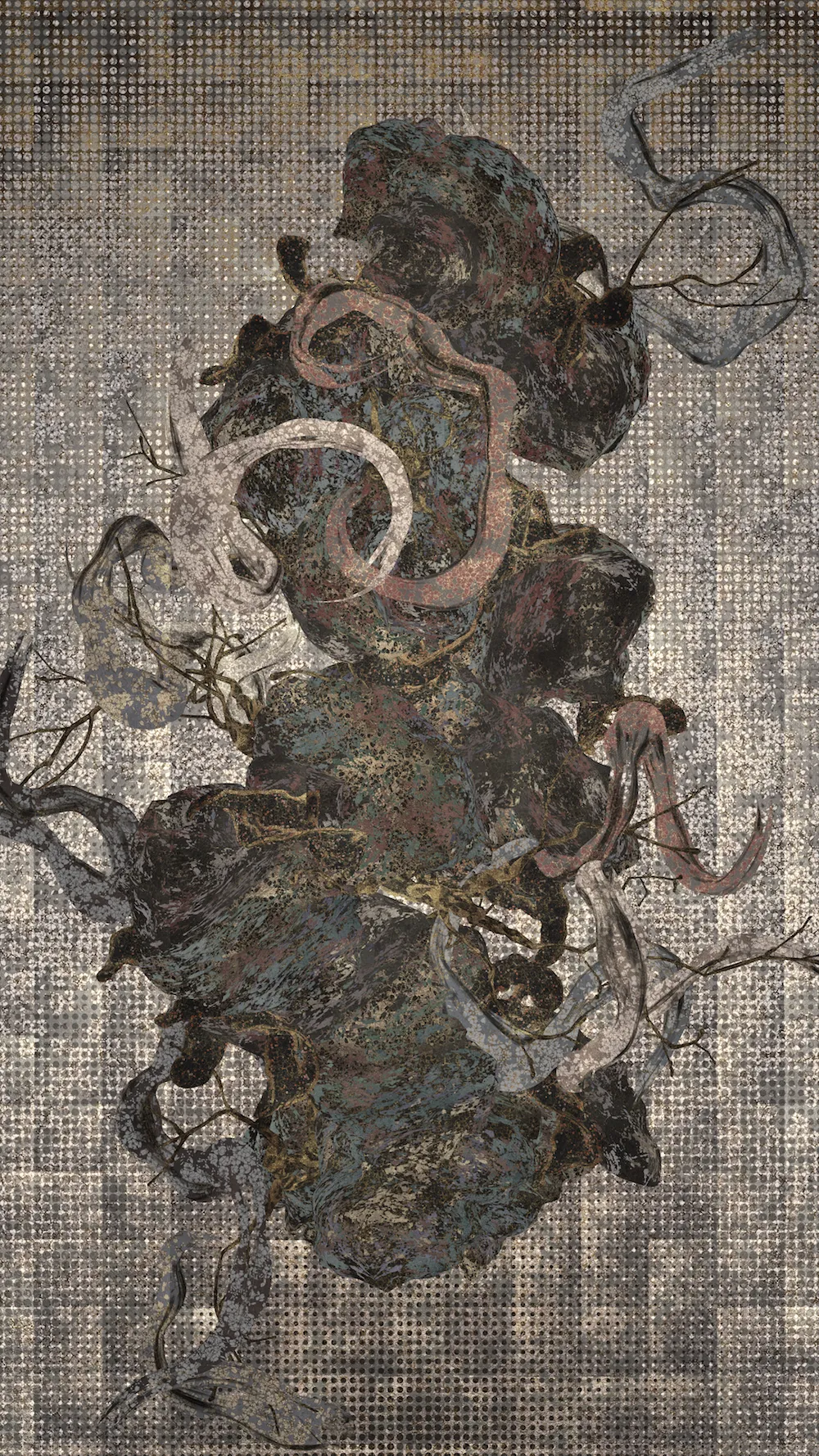
超主觀空間與數字藝術
2001
前現代知識:古代日本人的空間認知
從亞洲繪畫的角度看世界
teamLab探索的正是當代社會因缺乏兼容性而摒棄的東西,並且重點探索了前現代亞洲藝術視角下的空間意識。
直到十九世紀晚期,亞洲人刻畫世界的方式與今天還大不相同。古代的空間認知在當代社會中已經遺失。通過作品,我們探索了世界是否在空間維度上發生了變化,或者說,人們是否已改變過去看待事物的角度。
傳統繪畫多是“平面的”。我們相信,我們的祖先看待世界的角度與古代繪畫完全一樣,因為就連現代人對空間的認知也是通過具透視性質的繪畫或圖片。
換言之,我們認為,我們的先人形成了一套不同於西方文藝復興視角的空間認知邏輯結構。亞洲鄰國對前現代的影響很大,所以這套空間認知應該適用於整個亞洲。
古代空間認知——超主觀空間
teamLab試圖運用新穎的數字手段探索超主觀空間的邏輯結構。我們用電腦創造了三維空間——一個充滿三維物體的世界;然後從傳統藝術的視角將三維空間平面化,以期探索其邏輯結構,並稱其為超主觀空間。
我們沒有在平面上作圖,而是在三維空間中創造三維物體,然後運用超主觀空間中的邏輯構造將其扁平化,繼而根據這套邏輯結構制作多變的互動式創意作品。創作過程中會發現只有在超主觀空間中才會存在的特征和現像。通過這樣的空間探索,我們可以創造新穎的視覺體驗,並引發大家思考現代人們是如何理解世界的。【圖1、2】
圖1:透視平面圖裡三維空間中的三維物體(取自《花與屍 剝落十二幅對:繁榮與災難》(Flower and Corpse Glitch Set of 12: Disaster and Prosperity))
圖2:超主觀空間邏輯平面圖裡三維空間中的三維物體(取自《花與屍 剝落十二幅對:繁榮與災難》(Flower and Corpse Glitch Set of 12: Disaster and Prosperity))
Mov. 1:Finished painting (from “Flower and Corpse Animation Diorama”)
人的眼睛如何捕捉光線
簡單來說,西方視角源於手繪油畫【圖3】,通過刻畫線性系統,使物體在空間中漸退【圖4】。觀賞者透過手繪油畫視角看到的世界與繪畫和圖片所刻畫的一樣。
假設前現代時期的人以繪畫的視角看待世界【圖5】,人物與物體只存在於單一的深度平面上【圖6】。在這種視角下,人們無法看到維度;不過,人們也很少僅從單一的視角看待世界。
大多數人並沒有意識到,人眼在特定瞬間只能粗略地瀏覽事物,而不是繪畫或圖片描繪的寬泛視角。眼睛的自然轉動和焦點的變換決定了人類的視覺感知,在大腦中合成了窄景淺景,因此我們認為,人們只是感覺像看照片或圖片一樣看待透視圖。
也就是說,teamLab認為,人眼就像一款功能極差的相機,不停地根據心情拍攝周遭環境,在大腦中合成巨量圖像,從而對這些圖像產生空間認知。如果你認為大腦中的圖像合成采用了不同於透視法的邏輯結構,那麼看到圖6所展示的世界也就不足為奇了。
[Figure 3] Mona Lisa © RMN-Grand Palais (Musée du Louvre) / Michel Urtado / distributed by AMF-DNPartcom [ Figure 4 ] [ Figure 5 ] Honensho picture scroll [ Figure 6 ]
成為圖片或照片的一部分
假設你是透視圖片或照片中的一部分【圖7,紅色人像】,那麼可見景觀是會變化的。如果圖像正面朝前,你是從外部視角看待世界【圖7,粉色部分】。
假設前現代時期的人按照【圖8】的視角看待世界,即假設自己是傳統繪畫中的一部分【圖9,紅色人像】,那麼你看到的便是【圖9】中的粉色部分。換言之,繪畫中的人物幾乎是從外部視角看待【圖9】的。所以,即便觀賞者從繪畫中人物的視角看待繪畫,也能繼續看到繪畫中的景觀。所以,欣賞繪畫時,觀賞者可以假設自己置身於繪畫所描繪的空間中,自由活動。觀賞者無法凌駕於繪畫所刻畫的空間之上,而是融入其中。
[ Figure 7 ] [ Figure 8 ] [ Figure 9 ]
以觀賞者為中心
假設你將刻畫物體的數張圖片融入一張圖片中【圖10】,結果可能與從遠處將所有物體拍入一張照片中【圖11】完全不同。根據西方線性視角,即便將數幅平面圖緊密地合成一幅圖,受限於空間也僅能在投影平面中呈現很少一部分【圖10】,無法從遠景視角呈現整個空間;只有平面圖【圖11】才能呈現全部空間。
而在超主觀空間中,將數幅細節平面圖合成一幅平面圖【圖12】後所呈現的空間與單幅平面圖所呈現的整個空間【圖13】在邏輯上是一致的。即將數幅平面圖合成後產生的空間大小與單幅平面圖所呈現的空間大小是一致的。
也就是說,以觀賞者為中心是可能的。站在可以概覽全局的位置去欣賞繪畫,相信自己處於繪畫所呈現的整個空間中。靠近一點,找到一個僅能看到部分畫作的位置,你便只能進入那部分畫作所呈現的空間【圖12】。你可以自由移動位置,視角不受限制【圖13】。
傳統畫卷和紙質屏畫正是基於這一概念創作的。將畫卷放在桌子上,左手攤開畫卷,一幅幅畫面便呈現在眼前。也就是說,你看到的是整個畫卷的不同部分。紙質屏畫也是基於這樣的理念繪制的,即每屏畫面都可以移動。
【圖10】由小幅平面圖拼成的平面圖,每幅小圖都代表透視空間的一部分
【圖11】整個透視空間下的平面圖
【圖12】由多個小幅細節平面圖拼成的平面圖,每幅小圖都代表超主觀空間的一部分
【圖13】整個超主觀空間下的平面圖
切分,折疊,或合並
根據超主觀空間,我們可以隨意將平面圖“切分”成若干部分。如果只看其中一個部分,你在視覺上便會融入那部分所代表的空間中。也可以“折疊”空間。透視圖片或繪畫是無法折疊、切分或合並的,而在傳統藝術中這卻是常見做法。
根據定義,繪畫屏風其實是折疊的畫布,拉闔門則是切分的畫布。如果古人以超主觀空間的視角認識世界,那麼無論呈現在什麼樣的畫布上,他們看到的世界應該都是幾乎沒有變化的。他們可以輕易地完全融入到時代藝術所刻畫的圖像中,像看待世界一樣看待這些圖像。在古人看來,不管是在現實中還是在藝術中,他們都是這個世界不可分割的一部分。
在超主觀空間中觀賞者與世界之間沒有界限
如果按照西方視角所刻畫的那樣去看待世界,會發現藝術與現實完全不一樣,你無法完全融入那個世界。認識到這一點,我們便有理由去探索認識世界的新方式,從世界的面貌與人們的行為之間的關系上著手。
我們的先人與自然的關系不止於觀察。把自己視作自然的一部分不是思考的產物,而是在融入他們所觀察的世界後逐漸認識到的。
如果你曾以西方視角看待世界,便能理解你和你所觀察的世界之間那條清晰的界限。人是無法存在於那個世界中的。也就是說,那個世界本來便是用來觀察的。
現在我們經常聽到人們說“我們是地球的一部分”。而實際生活中,很多人將自己和世界割裂開來,好像這個世界與他們所處的世界並不是同一個世界。也許是因為當今社會中圖片和直播視頻泛濫,導致我們將自己與所觀察的世界分裂開來。
FEATURED WORKS

teamLab, 2012, Digital Work, 12 channels, 1 min 25 s (loop)
由12幅畫所組成,以「自然與文明的衝突、循環、共生」為主題的故事性繪畫。
在電腦上的三次元空間裡建構出立體性的作品世界,並根據「超主觀空間」的理論影像化。

生命即生命力的展現 / Life Survives by the Power of Life
teamLab, 2011, Digital Work, 6 min 23 s. (loop), Calligraphy: Sisyu
自然賦予我們恩澤,也帶給我們災難。同樣,我們受惠於文明的進步,也承受著這種進步帶來的負面影響。自然與文明總是相伴相生。時間沒有絕對的惡與善。我們很難理解也無法安放自己的情感和心緒。無論未來等待我們的是什麼,我們只能選擇去面對而不絕望地繼續生活。
作品集成型後,teamLab一直致力於探索空間書法。空間書法是從現代角度對抽像空間中傳統書法的闡釋。作品在三維空間中構建書法,彰顯了筆畫之間的深度、速度和力度。書法中的蝴蝶,鳥兒,動物,植物和鮮花傳遞著季節的變化。在禪宗佛教看來,“萬物皆承佛理”。萬事萬物都不是永恆的,事物的自然狀態便是佛性。我們所塑造的正是人類眼中生命的核心所在。
查看更多作品集成型後,teamLab一直致力於探索空間書法。空間書法是從現代角度對抽像空間中傳統書法的闡釋。作品在三維空間中構建書法,彰顯了筆畫之間的深度、速度和力度。書法中的蝴蝶,鳥兒,動物,植物和鮮花傳遞著季節的變化。在禪宗佛教看來,“萬物皆承佛理”。萬事萬物都不是永恆的,事物的自然狀態便是佛性。我們所塑造的正是人類眼中生命的核心所在。

無常的生命, 時空交匯之處誕生新的時空 / Impermanent Life, at the Confluence of Spacetime New Space and Time is Born
teamLab, 2018, Digital Work, 4 channels, Continuous Loop
這件作品的背景表現了櫻花從綻放到凋謝,一直重復著生與死的過程。接著從背景中心開始向外以固定的節奏產生一個逐漸變大的圓環,依據產生出來的圓環,改變著背景世界的明暗。
查看更多
teamLab, 2017, Digital Work, Single channel, 10 min (loop)
這件作品的背景表現了櫻花從綻放到凋謝,一直重復著生與死的過程。接著從背景中心開始向外以固定的節奏產生一個逐漸變大的圓環,依據產生出來的圓環,改變著背景世界的明暗。